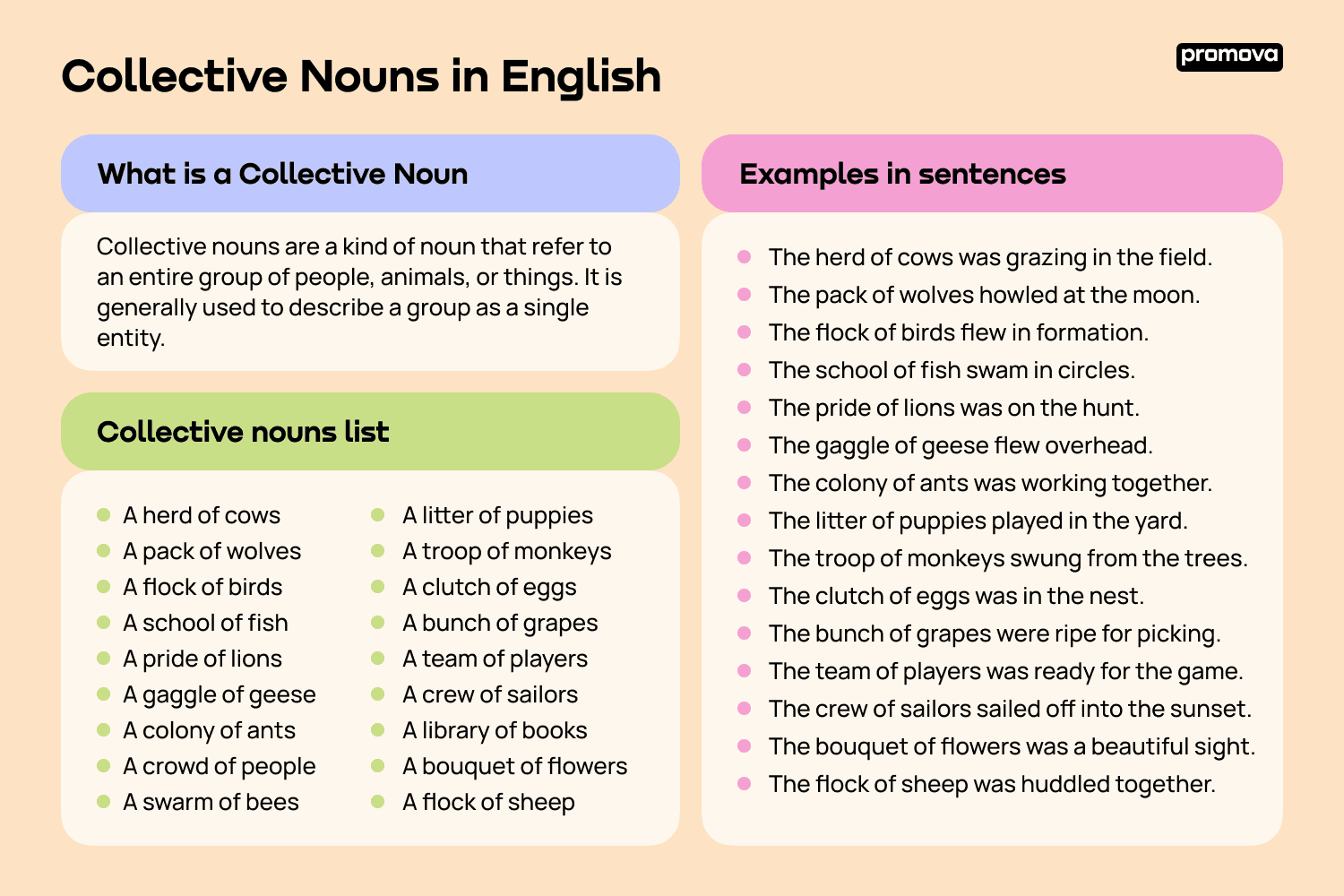Collective Nouns in English
Contents
Collective nouns are an important part of the English language and can be quite confusing to learn. In this reference, we'll discuss collective noun meaning, provide a list of collective nouns, give examples in sentences, and discuss the grammar rules involved.
What is a Collective Noun
Collective nouns are a kind of noun that refer to an entire group of people, animals, or things. It is generally used to describe a group as a single entity. Collective nouns can be used to describe a group of people, animals, or things that are similar or related. For example, the collective noun for a group of wolves is a "pack," while the same for cats is a “clowder.”
Collective nouns can be used to refer to a group of people, animals, or things that are not necessarily related. For example, the collective noun for a group of singers is "choir." They aren't intuitive for non-native speakers because they don't always match up with the singular form of the noun.
You're better off simply accepting and trying to remember the most common collective nouns rather than trying to figure them out logically.
Collective Nouns List
Some of the most common collective nouns in English:
- A herd of cows
- A pack of wolves
- A flock of birds
- A school of fish
- A pride of lions
- A gaggle of geese
- A colony of ants
- A crowd of people
- A swarm of bees
- A litter of puppies
- A troop of monkeys
- A clutch of eggs
- A bunch of grapes
- A team of players
- A crew of sailors
- A library of books
- A bouquet of flowers
- A flock of sheep
Collective Noun Examples in Sentences
Now that you know what a collective noun is, let's look at some examples of collective nouns in sentences.
- The herd of cows was grazing in the field.
- The pack of wolves howled at the moon.
- The flock of birds flew in formation.
- The school of fish swam in circles.
- The pride of lions was on the hunt.
- The gaggle of geese flew overhead.
- The colony of ants was working together.
- The crowd of people cheered as the team scored.
- The swarm of bees buzzed around the flowers.
- The litter of puppies played in the yard.
- The troop of monkeys swung from the trees.
- The clutch of eggs was in the nest.
- The bunch of grapes were ripe for picking.
- The team of players was ready for the game.
- The crew of sailors sailed off into the sunset.
- The library of books was filled with knowledge.
- The bouquet of flowers was a beautiful sight.
- The flock of sheep was huddled together.

Collective Noun Grammar
When using collective nouns, there are a few English grammar rules that you should follow.
Firstly, always use a singular verb with a collective noun. This means that when a collective noun is used, the verb should be in its singular form. For example, the sentence "The herd of cows was grazing in the field" is correct because the verb "was" is in its singular form.
Secondly, use a plural pronoun with a collective noun. This means that when a collective noun is used, the pronoun should be in its plural form. For example, the sentence "The crowd of people cheered as the team scored" is correct because the pronoun "they" is in its plural form.
Thirdly, use the singular form of a collective noun when referring to one member of the group. For example, the sentence "The sheep in the flock was lost" is correct because the collective noun "flock" is in its singular form.
It's also possible to have multiples of collective nouns. For example, if you wanted to refer to four separate flocks of sheep belonging to different people, you could say "The four flocks of sheep were huddled together".
Common Collective Noun Mistakes
Now that you know the grammar rules for collective nouns, let's look at some of the most common mistakes people make when using them.
One of the most common mistakes is using a plural verb with a collective noun. For example, the sentence "The herd of cows were grazing in the field" is incorrect because the verb "were" is in its plural form.
Another common mistake is using a singular pronoun with a collective noun. For example, the sentence "The herd of cows was grazing in the field" is incorrect because the pronoun "it" is in its singular form.
The third common mistake is using the plural form of a collective noun when referring to one member of the group. For example, the sentence "The sheep in the flocks was lost" is incorrect because the collective noun "flocks" is in its plural form.
7
Rare (and fun!) Collective Nouns
Here are some collective nouns you aren't likely to see in your daily life, but they're fun to learn either way:
- A cete of badgers
- A skulk of foxes
- A parcel of rabbits
- A siege of herons
- A exaltation of larks
- A flamboyance of flamingos
- A hover of trout
- A coalition of cheetahs
- A shrewdness of apes
- A crash of rhinos
Summary
Collective nouns are an important part of the English language and can be quite confusing to learn. A collective noun is used to point out a group of people, animals, or things. Collective nouns can be tricky to remember and use correctly, but with a few simple tips, you'll be able to do it in no time!
Comments